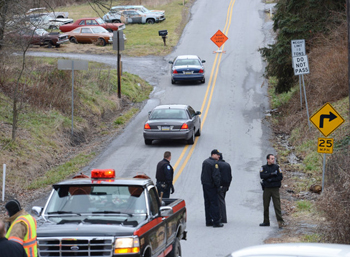
Hollidaysburg, December 22: A man shot a woman decorating for a children's Christmas party at a tiny church hall and killed two men elsewhere in a rural township on Friday before he was shot dead in a gunfight with state troopers.
Three troopers in patrol cars were injured in a pursuit that began after the gunman, driving a pick-up truck, fired at them, police said. One trooper injured a wrist and then was hit in the chest but was saved by a bulletproof vest.
The gunman was killed during a final exchange of gunfire after ramming his truck head-on into another police cruiser, authorities said.
The shootings began in Frankstown Township, in central Pennsylvania, at about 9 a.m, and investigators were processing five crime scenes within about a 1.5-mile (2.4-kilometer) radius, authorities said at a news briefing Friday afternoon. Troopers were responding to an emergency services call of a shooting in the township when they heard calls reporting at least one other shooting elsewhere, state police said.
"It's going to take us some time to put this all together ... and know exactly what occurred," said Lt. Col. George Bivens, deputy state police commissioner.
Authorities did not release the names of the victims or the shooter, though they did say the man lived in Blair County.
State police said they were still trying to piece together a timeline and motive. The gunman and the victims weren't related, though the victims may have been, at least distantly, Blair County District Attorney Rich Consiglio said.
Besides the woman, Bivens said, one man was shot at a residence, and the other man was shot at a crash site where the gunman "used his truck and also struck that vehicle much in the same manner that he did to our state police officer."
But family members of the victims said they were told the woman at the church was the first victim shot, the Pittsburgh Tribune-Review reported. The gunman then shot two men in the driveway of a home after a confrontation at a stop sign, one of the men's cousins, Marie Brenneman, told the newspaper.
"This person went to their driveway with a pistol, pointed at them and started shooting," Brenneman said.
She said both men were the shooter's neighbors in the tiny village of Geeseytown, about 70 miles (112 kilometers) west of Harrisburg, the state capital. "They were uneasy around him," she said.
The woman at Juniata Valley Gospel Church had cooked food the day before for the funeral of the church's longtime pastor, said the Rev. James McCaulley, his brother. The church was still reeling from the Rev. David McCaulley's death when the woman returned to decorate its hall - named after the pastor of 58 years - and bullets ripped through a window, he said.
The gunman then entered and shot one of two women before he left, the reverend said.
Police identified the five crime scenes as the church; a home and ground around the home; a crash site where another victim was killed; the point in the road where the gunman opened fire on the troopers; and where the final encounter occurred after the truck collided with the police cruiser.
Bivens said investigators don't know if the victims were picked at random.
Besides the trooper wounded twice, a second trooper was injured by glass fragments in his eye and bullet fragments that hit him in the forehead, Bivens said. The third trooper suffered minor injuries from the head-on crash, he said.
"I think we have three very fortunate state police members tonight," Bivens said. "We are very thankful for the fact that they survived this attack. Someone was watching over them."
McCaulley, who is the pastor of another church about 50 miles (80 kilometers) away from the site of Friday's carnage, said his older brother began leading the Frankstown church in 1954.
"He preached his last sermon at the church in October before he fell ill," McCaulley said.
The church, which lists about 150 members in an online want ad posted this month for an associate pastor, is close-knit, and the woman killed Friday was among its more active members, McCaulley said. She had made food for him to take home Thursday since his wife had died this year, he said.
Friday's shootings were the second involving a rural Pennsylvania church this month. An elementary school teacher is jailed on charges he fatally shot his ex-wife, a church organist, during a service in Coudersport on Dec. 2. The pastor and church members subdued him until police arrived.





Comments
Add new comment